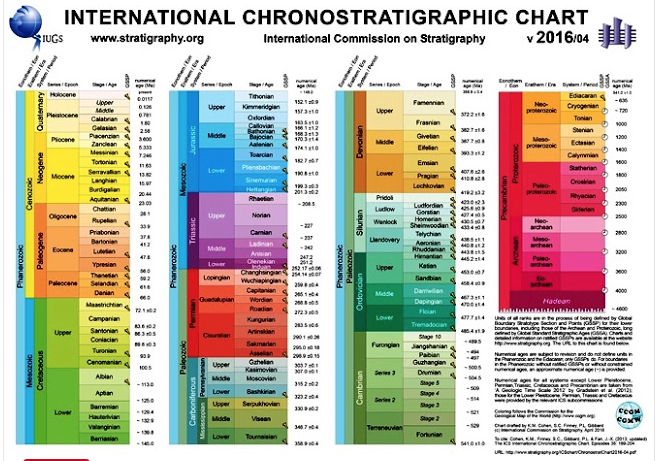The quest for the Golden Spike
Geology is sometimes seen as a boring, stuffy science dominated by scruffy old men with beards – not by me, I hasten to add – so how about this for a change of image to change and expand your mind?
Geology is the study of the Earth and, as the earth has a long history of some 4.56 billion years, it makes sense to split that long history into chunks – just like English history is split into the Stone age, Bronze age, Jacobean, Tudor, Elizabethan etc. Because geology is international and the same rocks are exposed at different places, in different countries around the world, ages and stages have to be decided internationally. This done by the International Commission on Stratigraphy ( ICS ) – a part of the International Union of Geological Sciences ( IUGS )

Nearly everyone has heard of Jurassic, Triassic and Devonian times but the problem is defining the start and length of each of these. These are also split into Epochs which are often called – not always – Upper, Middle and Lower. These are then split into Stages, then Zones and then sub Zones. The transition from each of these to the next is called a point.
For the purposes of this piece we will talk about the point that is at the transition from the Hettangian to the Sinemurian Stage in the Lower Jurassic Epoch, in the Mesozoic Era, in the Phanerozoic Eon. This point has been researched and defined to be 199.3 +/- 0.3 million years ago ( mya ). This defined point is also called a Golden Spike. It is shown as such on the International Stratigraphic chart. It is more fully known as a Global Boundary Stratotype Section and Point ( GSSP )

I’ll come to how this is worked out later but the problem now is finding a place somewhere in the world that exposes this point. It has to have several attributes: The succession must be exposed, it must be complete – and have several others. Semur-en-Auxois in Eastern France was proposed in 1842 but later research found that the strata was incomplete. Then in 18956-1858 then in 19061 and 1971 the coastal cliffs west of Lyme Regis were proposed. A later study in 1972 and then in 1984 found an exposure on the West Somerset coast that had five times the strata thickness of Lyme Regis. This exceptionally complete sequence, as best exposed north of East Quantoxhead, was proposed as the GSSP for the base of the Sinemurian Stage in 1995. Among the known sections across the Hettangian / Sinemurian boundary elsewhere in the world where sedimentation is believed to be continuous, the GSSP at East Quantoxhead offers the most complete succession of relatively well preserved ammonites. This section meets the requirements of the ICS for a GSSP. It has therefore been accepted as a GSSP by the Sinemurian Boundary Working Group, the ISJS and the ICS – almost unanimously – and was finally ratified by the IUGS in August 2000.
The location of the Golden Spike is described as 0.9 m above the base of bed 145 coinciding with the first appearance of the genera Vermiceras and Metophioceras. These are types of ammonites.

This is the first ever Jurassic Golden Spike in the UK. There have since been others, one in Robin Hoods Bay on the Yorkshire coast and one provisional one on Skye. The complete worldwide list is here.
http://www.stratigraphy.org/gssp/
Going back to how the age of this boundary was worked out:
The Cliff section at East Quantoxhead – and other exposures of the same age around the world contain fossils of ammonites. Ammonites are very useful for establishing comparative dates as they were spread around the ancient world and they evolved at a very fast rate. This means that different ammonite fossils occur in quite precisely known strata. These have all been charted so that a stage change eg Hettangian to Sinemurian in the lower Jurassic can be defined by the evolution of fossils.
This is explained in more detail here
http://jncc.defra.gov.uk/pdf/V30chap1_p1.pdf
There are, of course, other checks that can be carried out to confirm this. These include: Ostracods, foraminifers, palynomorphs, magnetostratigraphy and gamma ray log.
If you do follow this quest to East Quantoxhead, please keep well clear of the very fragile cliffs as there are often rock falls.
This coast is also a Site of Scientific Interest ( SSSI) so no hammering or fossil collecting from the cliffs is allowed. Please leave this beautiful nature for future generations to enjoy.
If you wish to find out more, I suggest you download the paper by Gert Bloos and Kevin Page ( March 2002 ) Global Stratotype Section and Point for base of the Sinemurian Stage ( Lower Jurassic ) which is freely available on the web.
Click to access Sinemurian.pdf
© Richard Kefford 2017 Eorðdraca
My Kindle books are on Amazon – Here

6 responses to “The quest for the Golden Spike”
Reminds me of ancient Egyptian history!
LikeLike
You’ve explained this so clearly, even a dunderhead like me understood it! It is very exciting!!!
LikeLike
Thanks Lois but I think not a dunderhead! I’m delighted you find this exciting – so do I.
LikeLiked by 1 person
I was excited when you told me about it – it here you’ve explained it so clearly that I understand properly why I should be excited!
LikeLike
I must stand up for geology here, Martha. Egyptian history only goes back a few thousand years but this Golden Spike Point in history has been waiting there for 200 million years for us to come along and find it..
LikeLike
[…] https://somersetwriters.wordpress.com/2017/07/03/the-quest-for-the-golden-spike/ […]
LikeLike